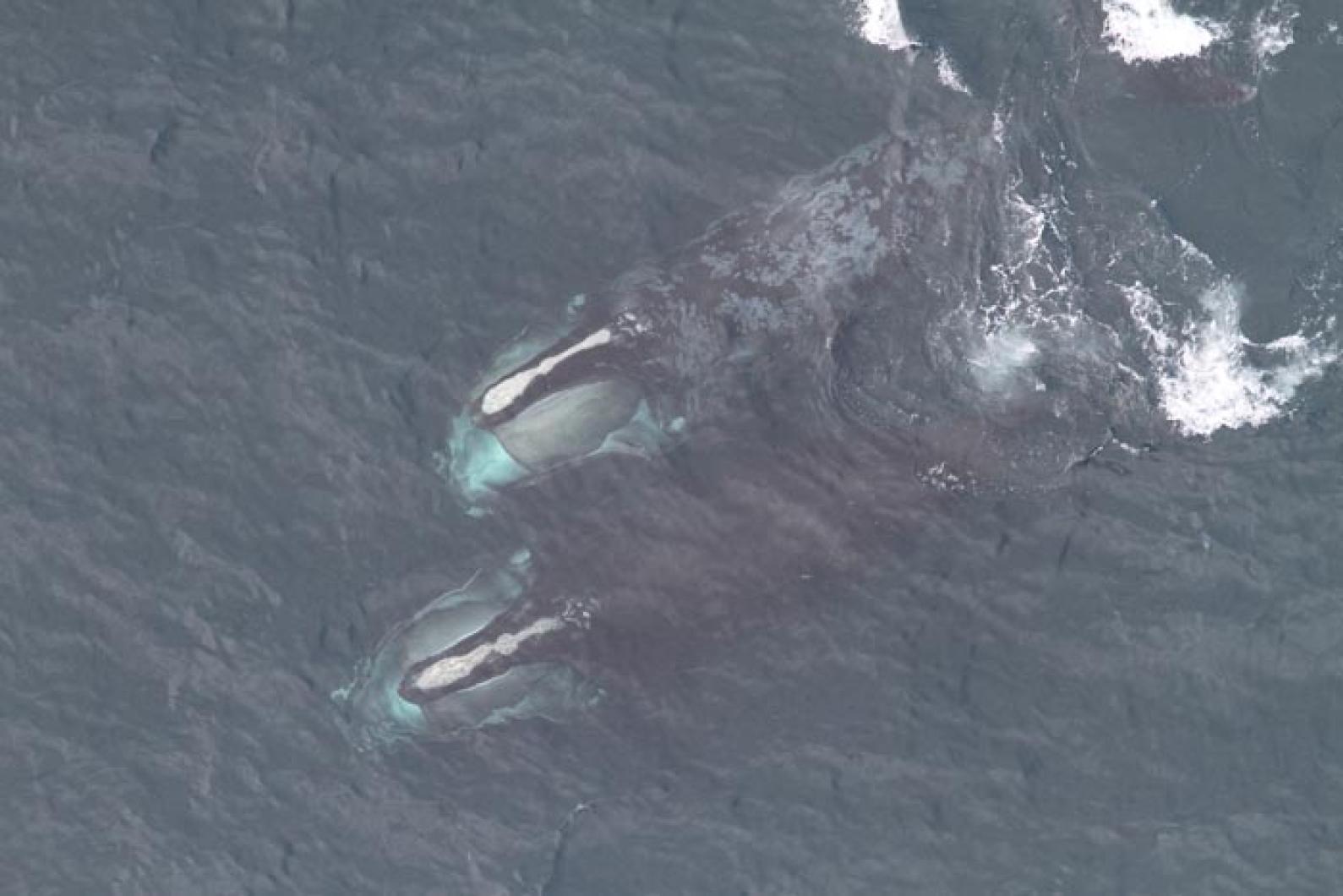This spring endangered Northern Atlantic right whales have been seen and photographed swimming in Vineyard waters. Marine scientists who monitor right whales, considered the rarest among marine mammals, reported seeing 57 whales off Noman’s Land and nearly a dozen south of the Vineyard two weeks ago. More than 200 whales, about half the known population, have been seen since January in Cape Cod Bay.
Crews of observers at the state and federal level, together with those from the Provincetown Center for Coastal Studies, are coordinating efforts to record the seasonal appearance of right whales. There is some optimism as scientists report seeing an improvement in the number of calves.
On a recent Saturday a crew of four, flying in a Cessna Skymaster for the Provincetown center, documented approximately 13 whales less than 20 miles south of the Vineyard. Laura Ganley, flight coordinator for the aerial survey team with the Provincetown center, said during the morning flight they saw a mother and calf pair. They also saw two sei whales. The crew was up in the air for four hours and were pleased with the preliminary data collected. Ms. Ganley said they are still reviewing the photographs and other information to determine the actual number of whales.
A flight across Rhode Island Sound three days later by federal observers was less productive. During that flight just one whale was spotted, suggesting that the whales had already moved eastward.
The largest sighting this season in waters around the Vineyard was recorded on Friday, April 22, by observers from the Northeast Fisheries Center at Woods Hole aboard a Twin Otter plane out of Barnstable Municipal Airport. They flew from west of Noman’s Land to an area off Rhode Island and found several groups of whales in waters west and south of Noman’s Land. “We saw a group of 14, another group of 17, five, eight and 13,” said Christin Khan, an aerial survey biologist for the center. “There were three mother and calf pairs,” she said. The area was about 10 miles west and southwest of Noman’s Land in water about 80 feet deep. That group of observers also documented six sei whales. The area around Noman’s Land, a one-square-mile island southwest of Aquinnah, is popular for lobster fishing during the late spring, summer and fall.
Right whales are about 50 feet long and weigh about 50 tons each. They are filter feeders and feed on copepods, one of the smallest of food sources in the sea.
“We do see right whales frequently, but it is rare to see them this close to the Vineyard,” Ms. Khan said. “It is certainly encouraging to see them in this area.” There was an unconfirmed report of three right whales spotted in Nantucket Sound.
Right whales were abundant in this area two centuries ago, when they were easily hunted. The New England whaling era was at its peak from the late 1700s into the 1800s. The whales have been protected for many decades, and in the last few years their numbers may have increased slightly. Marine scientists are engaged in ongoing discussions over whether the increase in population, about two per cent per year, is the cause of the whales expanding their territory.
Erin Burke, a protected species specialist with the Massachusetts Division of Marine Fisheries, said the whales come each spring in search of food as part of their seasonal migration. They spend the winter in the warmer waters around Florida, and by the time they begin to migrate north they are hungry and in search of food. “They haven’t eaten anything down in the Southeast, Florida, Georgia and Carolinas. There is no food there. They go there to calf. Their first meal may be in our waters,” Ms. Burke said.
When the whales feed they often form concentrated groups in one area, Ms. Burke said. When they make a short-term appearance, she said: “They must have found some food, mowed it down and headed on.” This is what happened a year ago off Rhode Island, to the surprise and delight of scientists.
From an airplane, the sight of a pod of whales feeding is impressive, Ms. Khan said. Describing the April 22 flight, she said: “We saw three mothers and their calves. The entire species has 400 animals. In this past year there were 21 new calves born. We saw three of them,” she said.
The whale experts converse with each other daily. They believe the whales are now gathering at South Channel, southeast of Chatham.
Ms. Burke said that while there has been a slight increase in the population from year to year in the last decade, there is still serious concern about the survival of the species because the numbers are so low. No one wants the right whale to follow in the path of the North Atlantic gray whale, now extinct.
As a result right whales are vigorously protected. Anyone who spots one is required to stay at least 500 yards away. Efforts have been stepped up to reduce ship strikes, a major cause of death for all whales. Unauthorized airplanes flying over whales are required to stay at least 1,000 feet up.
Two years ago Massachusetts, along with other states, adopted new regulations for lobster and other pot fishermen, requiring them to switch from floating to sinking lines for their pots. The rules are designed to reduce the chance that whales will become entangled in the line.
More restrictions are expected in the near future. Bill Adler, president of the Massachusetts Lobstermen’s Association, said sometime this summer the federal government is expected come out with an informal proposal to minimize the use of buoy lines for pot fishermen.







Comments
Comment policy »